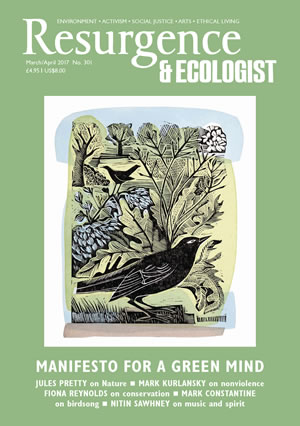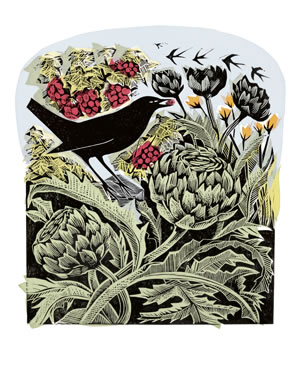If you’ve not been paying attention to the rich and beautiful canopy of British spring birdsong in the early morning countryside, you’re already too late. It’s gone, or at least going.
Tucked up in tractor cabs and wearing ear protectors as they spray their fields, our farmers and their contractors have hardly noticed the loss of three-quarters of skylarks in a generation. Or that half the yellowhammers that delighted Thomas Hardy have taken their “little bit of bread and no cheese” up to him in the heavens. Lost with them have been the peewits that once thundered across the fields, the curlews and the snipe that “curlied” and winnowed through the landscape, the clockwork grey partridge, and the quail who no longer “wets his lips” in the long grasses.
It’s the same story in the woods. Turtle doves’ gentle purring; marsh and willow tits’ songs that are, superficially, all that separates them; spotted flycatchers and redstarts now almost out of earshot in southern England as they are massacred on migration further afield. Fishermen and wildfowlers will have seemed kinder, as their own industrial practices have left more birds calling across the marshes.
Although this may sound like the apocalypse, it’s not so hopeless. When I first went to Pollensa in northern Mallorca for my family holiday, there was no dawn chorus. While my family slept, I recorded birdsong there, and in the 1980s there was no morning birdsong. Plenty of cocks crowing and dogs barking, perhaps a wryneck’s repeated calls and a hoopoe’s song, but precious little else.
We would take our holiday over Easter in order to shake off the British winter a few weeks before spring. Unfortunately, the locals had eaten all the songbirds by then, just to see them through the winter, and seeing a robin, chaffinch, song thrush or blackbird there was an event worthy of a diary mention. As time has passed and tourism increased, this shooting and catching habit has died out and, left to their own devices, the blackbirds and song thrushes have started to sing again. Now Mallorcans can whistle along to a new dawn chorus as they hammer away converting fincas to villas.
Our gardens and villages and the green lanes and hillsides that rise from them are still safe havens for birds. Our feeders and our orchards with their tiger moths provide the dinner, and the various tits, blackbirds and cuckoos sing for it. Feeding birds during winter has become increasingly popular, although my neighbours normally complain about our morning chorus. “What is that dreadful cooo coo coo… cooo coo coo… every morning at four-fifteen?” “Collared dove,” I answer. “Every morning? It drives me crazy.” By feeding their birds, they support it. The best and strongest blackbird, robin and song thrush will dominate the richest habitat, and if you get your feeding right you could have the richest morning chorus in the street.
Our bedroom is styled on Gregory Peck’s apartment in the film Roman Holiday, with doors at either end leading to verandas or, as I prefer to think of them, bird platforms. In spring we sleep with both doors open. From April to June a marvellous blackbird sings from the eaves of the roof at around five in the morning and its song fills the room, slowly bringing us to wakefulness. While it is a naturally relaxing sound and I could be lying abed enjoying the Nature care therapy that the song provides, I really like to record it.
I record sounds with Arnoud van den Berg and Magnus Robb. Together with Dick Forsman and Killian Mullarney we form The Sound Approach, and between us we have amassed a collection of 60,000 recordings, mostly of the birds of Europe. Bird sound recording has only been possible since the late 19th century, and it was very difficult in the early days. Pioneer Ludwig Koch would use a stabilised lorry just to carry all his equipment. Things have become much easier now, and all of our sounds are recorded digitally in stereo. Which means that a collector like me can lie there with the microphones close to the blackbird while I’m under the duvet with my earphones and digital recorder. Why don’t you join me and my wife Mo – she’s the one snoring gently – and listen to track 1 while you read on?
A blackbird in the morning: Common blackbird (Turdus merula), Poole, Dorset, England, 04:57, 28 June 2016, recorded by Mark Constantine. Singing from the eaves of the roof just above a ‘bird platform’, recorded from under the bedcovers.
You can’t sell birdsongs for a good living, so one of my jobs is to create treatments for the Lush Spa. Whilst listening to dolphin and whale sounds is a cliché of spa treatments, it is when I introduce recordings of birdsongs into the soundtracks that we have noted the biggest drop in blood pressure and heart rate in the listener. There are measurements of the role that birdsongs have in modern life, but they don’t catch the true value. So the argument is the same as for other human functions – use your hearing, or lose it. As for the spiritual, in a world of crushingly negative political cant, sitting beside a singing blackbird is the only guaranteed way I’ve found to feed my soul. So by now if you have been listening to ‘my’ blackbird singing, the anxiety I created by telling you that you have missed rich morning choruses will have passed and you’ll be ready for a few solutions.
Apart from feeding birds, buying organic fruit and veg helps. A ban on all industrial pesticides would create a revolution in farmland birdsong. Recently New Scientist printed a spirited attack on organic farming practices, arguing that they are environmentally more damaging than “normal” practice. While I do hope that buying organic will slow climate change, for me New Scientist is missing the point. I want my food produced in a system that encourages insects, birds and therefore birdsong.
Enough of conservation talk. It’s time to take a walk in birdsong in the spring, and we are starting at Corfe, Dorset at the base of the castle by the river in the village. On a Sunday morning a family are playing Poohsticks on their way to church. The series of recordings accompanying this article represents a walk from the castle under the steam train bridge and up Challow Hill, finishing with Poole Harbour’s only remaining nightingales.
Learning to listen is arguably more rewarding than committing each birdsong to memory. While visual recognition involves memorising plumage patterns that vary within fairly narrow limits, the sounds produced by a bird one moment and the next may bear no resemblance to each other at all: they vary dramatically according to behaviour, and an experienced listener will take this into account. Now let’s listen to our second recording in detail.
A Corfe chorus, and a game of Poohsticks: Morning chorus along the Corfe River, and a game of Poohsticks, Dorset, England, 08:55, 5 May 2009 (recorded by Mark Constantine). Songs of Eurasian nuthatch (Sitta europaea), common chiffchaff (Phylloscopus collybita), common chaffinch (Fringilla coelebs), western jackdaw (Corvus monedula) and Eurasian wren (Troglodytes troglodytes). In the background, also song of European blue tit (Cyanistes caeruleus) and calls of dunnock (Prunella modularis).
At first we hear the church bells and the River Corfe. It is shallow enough to sound a little like chips frying as it rushes between the stones. In the distance a nuthatch is repeating hear hear hear in a high-pitched voice, and after five seconds a chiffchaff sings a gold-plate piece of onomatopoeia:
chiff chaff chiff chaff. Then, at centre stage, a chaffinch sings one good phrase.
I’m sorry if that was all in some sort of rush, but we are only 15 seconds into the recording. A car passes and changes gear as it climbs the hill. Things settle down and from 0:35 on the timer, the chaffinch holds the stage: simple songs quite confidently belted out above the river and in front of the bells. From the regularity of the songs, we can hear that this is an adult. Were he singing at an inconsistent pace and with little quiet phrases sung in the gaps, he could be a young male. Female chaffinches prefer dependable songs and ignore too much bird experimentation. Meanwhile, our male will be listening for degradation in the songs of his neighbours, things like loss of high frequency and reverberation, to work out how far away they are.
At around 2:20 you can hear a sound often associated with church towers: jackdaws, chacking away. Typically sounding like a small flock, this may be just a single bird. A wren now sings where the chaffinch was before. Its songs are twice as long, at a different pitch and with a faster delivery. Meanwhile, the children have started breaking sticks for their game. The wren carries on singing while the chaffinch returns with a slightly different variation of its song. The game is won, and Mum is second. The birds meld together as the bells stop. The river runs on.
To listen to additional birdsongs, click on the links below:
Common chiffchaff (Phylloscopus collybita) and steam train, Corfe Castle, Poole Harbour, Dorset, England, 09:00, 1 June 2008 (Mark Constantine). Song of a male, with trr-trr notes in between strophes. Background: Eurasian wren (Troglodytes troglodytes), European robin (Erithacus rubecula), common blackbird (Turdus merula), song thrush (Turdus philomelos), common chaffinch (Fringilla coelebs) and European greenfinch (Chloris chloris).
Song Thrush (Turdus philomelos) Purbeck Hills near Corfe Castle, Dorset, England, 09:00, 1 June 2008 (Mark Constantine). Song of a male, accompanied by church bells. Background: common wood pigeon (Columba palumbus), Eurasian wren (Troglodytes troglodytes), dunnock (Prunella modularis), common chiffchaff (Phylloscopus collybita) and common chaffinch (Fringilla coelebs).
Common chaffinch (Fringilla coelebs), Challow Hill, Dorset, England, 09:00, 1 June 2008 (Mark Constantine). Song of a male. Background: rook (Corvus frugilegus), Eurasian blackcap (Sylvia atricapilla), common treecreeper (Certhia familiaris), Eurasian wren (Troglodytes troglodytes), song thrush (Turdus philomelos), dunnock (Prunella modularis) and Eurasian bullfinch (Pyrrhula pyrrhula).
Common pheasant (Phasianus colchicus), Challow Hill, Dorset, England, 09:00, 1 June 2008 (Mark Constantine). Crowing and wing flutter of a male. Common wood pigeon (Columba palumbus), common chiffchaff (Phylloscopus collybita), Eurasian wren (Troglodytes troglodytes), common blackbird (Turdus merula), song thrush (Turdus philomelos) and European robin (Erithacus rubecula).
European robin (Erithacus rubecula), Challow Hill, Dorset, England, 19:38, 4 May 2010 (Mark Constantine). Song of a male. Background: common blackbird (Turdus merula), song thrush (Turdus philomelos) and lesser whitethroat (Sylvia curruca).
Common nightingale (Luscinia megarhynchos), Challow Hill, Dorset, England, 19:11, 4 May 2010 (Mark Constantine). One of the two males sings to the accompaniment of church bells. Background: Eurasian wren (Troglodytes troglodytes), common blackbird (Turdus merula), song thrush (Turdus philomelos), Eurasian blackcap (Sylvia atricapilla) and common chaffinch (Fringilla coelebs).
Tawny owl (Strix aluco), Middlebere, Dorset, England, 19:41, 29 April 2011 (Mark Constantine). Kuwick calls as a female emerges from her roost and flies past at fairly close range, being mobbed by common blackbird (Turdus merula). Background: greater Canada goose (Branta canadensis), common shelduck (Tadorna tadorna), Eurasian reed warbler (Acrocephalus scirpaceus), song thrush (Turdus philomelos) and European robin (Erithacus rubecula).







